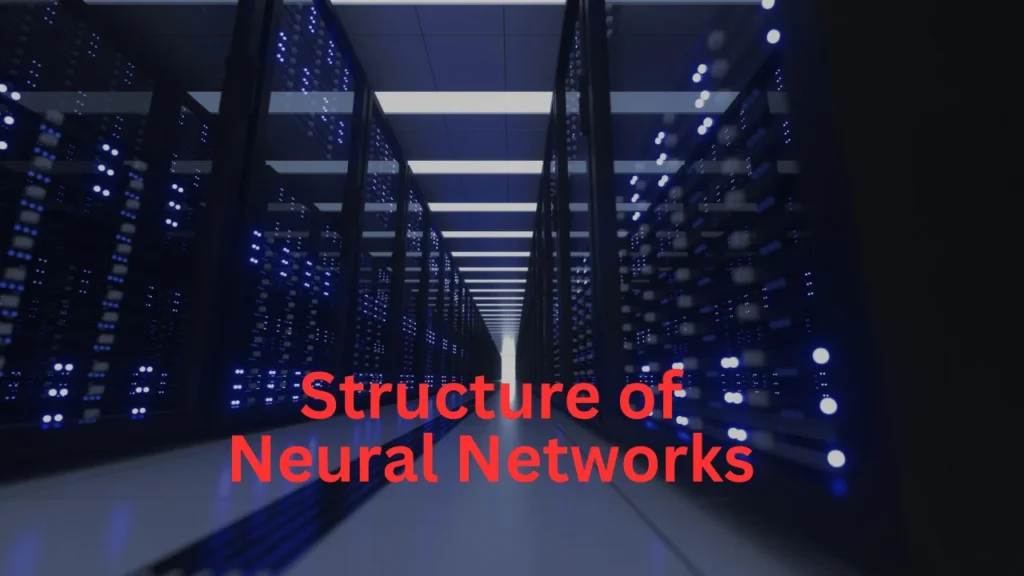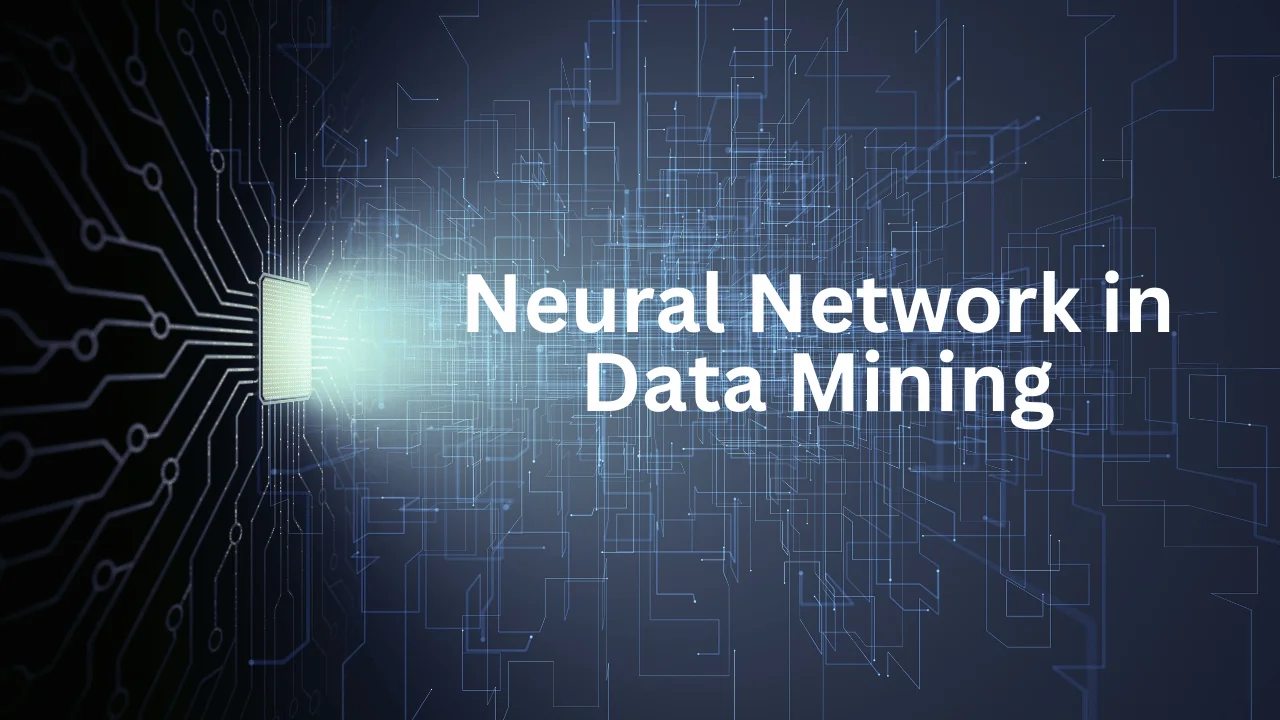Introduction
Neural network in data mining have changed the game by using their complex algorithms to find patterns and insights in massive datasets that were previously impossible to find. These networks excel at processing high-dimensional data and learning from it using techniques like supervised and unsupervised learning because they mimic the structure of the human brain.
Neural Networks in Data Mining
When it comes to classification, regression, clustering, and anomaly detection, neural networks are the way to go because of how efficiently and accurately they perform. Predictive analytics rely heavily on their capacity to learn intricate data relationships; this allows companies to make highly accurate predictions about trends, consumer behavior, and market dynamics. To top it all off, neural networks can be tailored to work better in niche industries like e-commerce, healthcare, and finance thanks to their malleability.
Structure of Neural Networks

Each node in a neural network is like a neuron in the human brain; these networks are built up of layers of them. Input, hidden, and output layers are the three primary organizational structures for these nodes.
Input Layers
When information is input into a neural network, it goes through the input layer. In this layer, each neuron stands for a dataset variable or feature. There is a direct correlation between the amount of input features and the amount of neurons in the input layer.
Hidden Layers
The input data undergoes a series of transformations in the hidden layers. Neurons in these layers carry out calculations and relay the outcomes to subsequent layers. The ability of a neural network to learn more complex patterns is enhanced as the number of hidden layers increases.
Output Layers
The ultimate categorization or prediction is made by the output layer. This layer’s architecture can range from having a single neuron for binary classification to having several neurons for multi-class classification, depending on the nature of the task at hand.
Activation Functions
Neural networks are able to learn intricate patterns because activation functions bring non-linearity to the model. The Rectified Linear Unit (ReLU), the sigmoid function, and tanh are three popular activation functions.
Backpropagation and Optimization
In order to reduce prediction error, backpropagation updates the neural network’s weights. These weights are iteratively adjusted using optimization techniques such as gradient descent.
Applications of Neural Networks in Data Mining

Data mining uses neural networks for many tasks, such as clustering, classification, regression, and anomaly detection.
Classification
Sorting information into predetermined groups is what classification is all about. The ability to learn from labelled data allows neural networks to anticipate the type of unlabeled data. In the field of image recognition, for instance, a neural network can determine if a picture has a cat in it or not.
Regression
Continuous values can be predicted using regression analysis. Tasks like predicting home prices using characteristics like location, size, and age are well-suited to neural networks because of their ability to model complex relationships between variables.
Clustering
Data points are grouped into clusters using clustering when they share similarities. For tasks such as picture compression and market segmentation, neural networks, especially when trained with autoencoders, are able to execute efficient clustering.
Anomaly Detection
Unusual patterns that don’t fit the norm can be found using anomaly detection. Neural networks excel at spotting outliers in many different kinds of data, including financial transaction fraud and industrial equipment malfunctions.
Benefits of Using Neural Networks
Enhanced accuracy, handling of high-dimensional data, and application adaptability are just a few of the advantages that neural networks offer to data mining.
Improved Accuracy
With the ability to learn from large datasets and spot complex patterns, neural networks can classify and predict with remarkable accuracy.
Handling High-Dimensional Data
When dealing with big datasets that contain many features, neural networks excel because of their ability to process high-dimensional data.
Adaptability
The performance of neural networks can be improved in many domains through application-specific tuning, including e-commerce, healthcare, and finance.
Continuous Learning
As they learn from more data, neural networks get better and better at updating their learning algorithms using optimization techniques like backpropagation.
Robustness
In other words, neural networks can keep performing well even if the input data is inaccurate or contains irrelevant information because they are resistant to data noise.
Role of Neural Networks in Predictive Analytics
The goal of predictive analytics is to foretell potential outcomes by analyzing existing data. The capacity of neural networks to learn from big datasets and model complicated relationships makes them very effective in this field.
Forecasting Trends
In order to forecast future events, neural networks can examine past data for patterns. This is useful in many fields, including the financial sector, where accurate stock price predictions can result in substantial profits.
Customer Behavior Analysis
In order to forecast consumer actions like spending habits and retention rates, neural networks sift through mountains of data. Because of this, companies can enhance client retention by customizing their marketing strategies.
Market Dynamics
To better understand the market and the factors that affect it, neural networks can simulate market dynamics. Companies that want to keep up with the market must do this.
Supply Chain Optimization
By optimising inventory management, demand forecasting, and disruption detection, neural network-powered predictive analytics can streamline supply chains.
Healthcare Predictions
Healthcare providers can make more informed decisions and allocate resources more efficiently with the help of neural networks that can forecast disease outbreaks, patient outcomes, and the efficacy of treatments.
Neural Networks vs. Other Data Mining Techniques
Many data mining methods, including neural networks, decision trees, and k-nearest neighbors (k-NN), are compared to one another. Every approach has advantages and disadvantages.
Decision Trees
Decision trees are straightforward and easy to interpret, which makes them a breeze to work with. On the other hand, when pitted against neural networks, they might struggle with complicated datasets.
Support Vector Machines (SVMs)
Support vector machines (SVMs) shine in classification tasks, particularly when dealing with datasets of small to medium size. On the other hand, neural networks are more capable of processing bigger datasets with intricate patterns.
K-Nearest Neighbors (k-NN)
It is an easy-to-understand algorithm that works fine with relatively tiny datasets. When it comes to handling high-dimensional data and large datasets, neural networks perform better than k-NN.
Ensemble Methods
To achieve better results, ensemble methods merge numerous models. Examples of this are gradient boosting and random forests. To improve their predictive power, these ensembles can incorporate neural networks.
Deep Learning
Networks with numerous layers are used in deep learning, a branch of neural networks. When compared to other data mining techniques, deep learning models perform better on tasks like image and speech recognition.
Best Practices for Using Neural Networks
Adhering to best practices is crucial for neural networks to perform at their best in data mining.
Data Preprocessing
In order to prepare data for training neural networks, data must first be cleaned and transformed. Data normalization, encoding categorical variables, and handling missing values are all part of this step.
Feature Engineering
The goal of feature engineering is to enhance model performance by generating new features from preexisting data. Feature engineering that successfully captures the data’s underlying patterns is crucial for neural networks.
Model Selection
It is critical to select the appropriate neural network architecture. Layer count, activation function type, and optimization algorithm are all important considerations.
Hyperparameter Tuning
Learning rate, batch size, and epoch count are some of the hyperparameters that can be fine-tuned to achieve optimal model performance. Some methods that can be used include random search and grid search.
Model Evaluation
To make sure the model works well with new data, you must test it. Classification tasks frequently make use of metrics like F1 score, recall, accuracy, and precision.
Avoiding Overfitting
When a model does well on training data but badly on new data, this is called overfitting. Methods such as regularization, early stopping, and dropout can be used to avoid overfitting.
Advanced Techniques in Neural Network Data Mining
Convolutional Neural Networks (CNNs)
One subset of neural networks, Convolutional Neural Networks (CNNs) excel at processing visual and geographical information. CNNs utilize backpropagation and a number of building blocks, including convolution, pooling, and fully connected layers, to automatically and adaptively learn feature spatial hierarchies.
Feature Extraction with CNNs
To get features out of data, CNNs use convolutional layers. By applying filters to the input, these layers generate feature maps that depict patterns and hierarchies in space. Activities such as object detection and image recognition rely heavily on this procedure.
Pooling Layers
While reducing computational complexity, pooling layers decrease the dimensionality of feature maps while retaining important information. One typical method employed by CNNs is max pooling, which involves selecting the highest value from a specific area of the feature map.
Applications in Data Mining
Convolutional neural networks (CNNs) are very effective in data mining for tasks like medical image analysis, face recognition, and picture classification. Jobs requiring comprehension of spatial hierarchies are a perfect fit for their visual data processing and analysis abilities.
Recurrent Neural Networks (RNNs)
Time series analysis, natural language processing, and speech recognition are some of the many applications that can benefit from Recurrent Neural Networks (RNNs). These networks are specifically built for sequential data and temporal dynamics. Recurrent Neural Networks (RNNs) can remember past inputs thanks to their directed cycle connections.
Time-Series Analysis
Because of their ability to learn from sequential patterns in data, RNNs are highly effective in time-series analysis. Applications that rely on this capability are weather forecasting, stock price prediction, and sensor data analysis.
Long Short-Term Memory (LSTM) Networks
By utilizing memory cells that can maintain information over long periods, LSTM networks—a type of RNN—address the vanishing gradient problem. Translation and video analysis are two examples of tasks that benefit greatly from LSTMs because of the long-term dependencies they entail.
Natural Language Processing
Applications of RNNs and LSTMs in NLP include sentiment analysis, text generation, and language modeling. They are highly effective tools for textual data analysis due to their capacity to comprehend context and sequential dependencies.
Generative Adversarial Networks (GANs)
A generator and a discriminator are the two main components of a Generative Adversarial Network (GAN). The generator network produces data and the discriminator network determines whether or not it is authentic; the two networks compete with one another.
Data Generation
The goal of using GANs is to create synthetic data that closely resembles real data. Data augmentation, building massive datasets for model training, and producing photorealistic images and videos all benefit greatly from this capability.
Applications in Data Mining
Image synthesis, data augmentation, and anomaly detection are some of the data mining tasks that can be accomplished with GANs. Because they are able to produce realistic training samples, they shine in situations where labelled data is scarce.
Autoencoders
When it comes to dimensionality reduction or anomaly detection, autoencoders—which are unsupervised neural networks—are the go-to tools for the job.
Dimensionality Reduction
Data visualization, clustering, and noise reduction are just a few of the many applications for autoencoders, which compress data into a lower-dimensional representation. Reduced computational costs while critical information is preserved are achieved through this process.
Anomaly Detection
Autoencoders learn the typical patterns in data and look for outliers, or anomalies, when they see them. Fraud detection, network security, and manufacturing quality control are all tasks that can benefit from their suitability.
Frequently Asked Questions
How do neural networks improve data mining processes?
Neural networks improve data mining processes by learning complex patterns in data, leading to more accurate predictions and classifications. They can handle large, high-dimensional datasets and continuously improve through iterative learning.
What are the applications of neural networks in data mining?
Applications of neural networks in data mining include classification, regression, clustering, and anomaly detection. They are used in various fields such as finance, healthcare, e-commerce, and supply chain management.
How to use neural networks for data mining?
To use neural networks for data mining, start by preprocessing the data, selecting the appropriate neural network architecture, and tuning hyperparameters. Train the model on labeled data, evaluate its performance, and make adjustments as necessary.
What are the advantages of neural networks in data mining?
Advantages of neural networks in data mining include improved accuracy, the ability to handle high-dimensional data, adaptability to different applications, continuous learning, and robustness to noise.
How do neural networks detect anomalies in data mining?
Neural networks detect anomalies by learning the normal patterns in data and identifying deviations from these patterns. Techniques like autoencoders and convolutional neural networks (CNNs) are commonly used for anomaly detection.
Also Check: Mining Engineering Colleges in India
Conclusion
Ultimately, game-changers neural networks in data mining, revolutionizing our data analysis and interpretation processes. Anomaly detection, clustering, classification, and regression are some of the many tasks that benefit greatly from their capacity to learn from complicated, high-dimensional datasets. Businesses and researchers can drive innovation across various domains by following best practices and leveraging their continuous learning capabilities. This will unlock valuable insights.

Brandy Stewart, an enchanting wordsmith and seasoned blogger, weaves compelling narratives that transport readers to uncharted territories. Infused with perceptive viewpoints and dynamic storytelling, Doris exhibits a command of language that enthralls both hearts and minds, leaving a lasting mark on the literary panorama.

